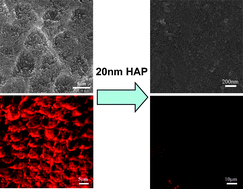Repair of enamel by using hydroxyapatite nanoparticles as the building blocks
Abstract
The application of calcium phosphates and their

* Corresponding authors
a
Centre of Biopathways and Biomaterials, Department of Chemistry, Zhejiang University, Hangzhou, Zhejiang 310027, China
E-mail:
rtang@zju.edu.cn
Fax: +86 571 87953736
Tel: +86 571 87953736
b First Affiliated Hospital of Zhejiang University College of Medicine, Hangzhou, Zhejiang 310003, China
The application of calcium phosphates and their

 Please wait while we load your content...
Something went wrong. Try again?
Please wait while we load your content...
Something went wrong. Try again?
L. Li, H. Pan, J. Tao, X. Xu, C. Mao, X. Gu and R. Tang, J. Mater. Chem., 2008, 18, 4079 DOI: 10.1039/B806090H
To request permission to reproduce material from this article, please go to the Copyright Clearance Center request page.
If you are an author contributing to an RSC publication, you do not need to request permission provided correct acknowledgement is given.
If you are the author of this article, you do not need to request permission to reproduce figures and diagrams provided correct acknowledgement is given. If you want to reproduce the whole article in a third-party publication (excluding your thesis/dissertation for which permission is not required) please go to the Copyright Clearance Center request page.
Read more about how to correctly acknowledge RSC content.
 Fetching data from CrossRef.
Fetching data from CrossRef.
This may take some time to load.
Loading related content
